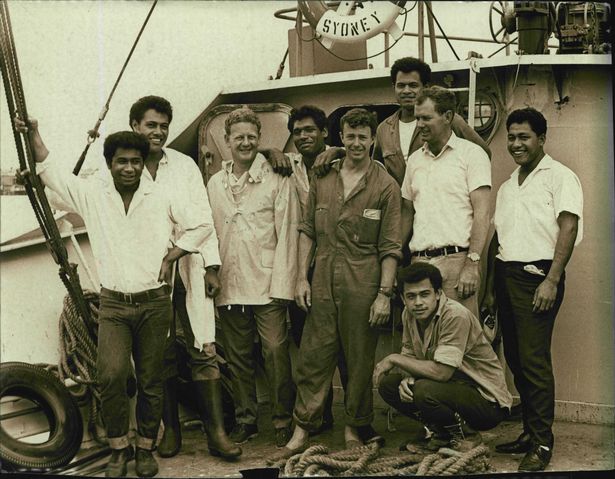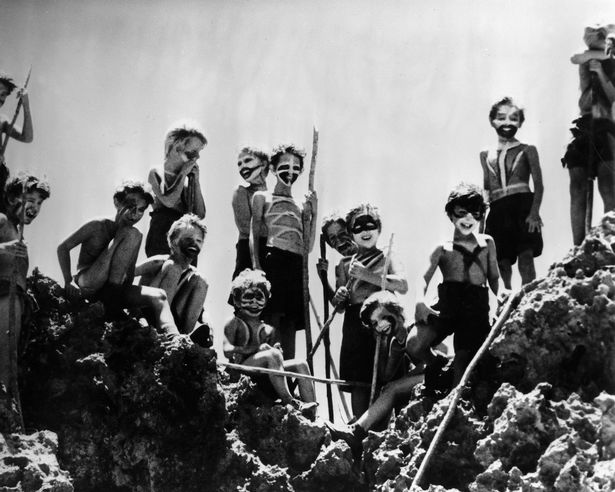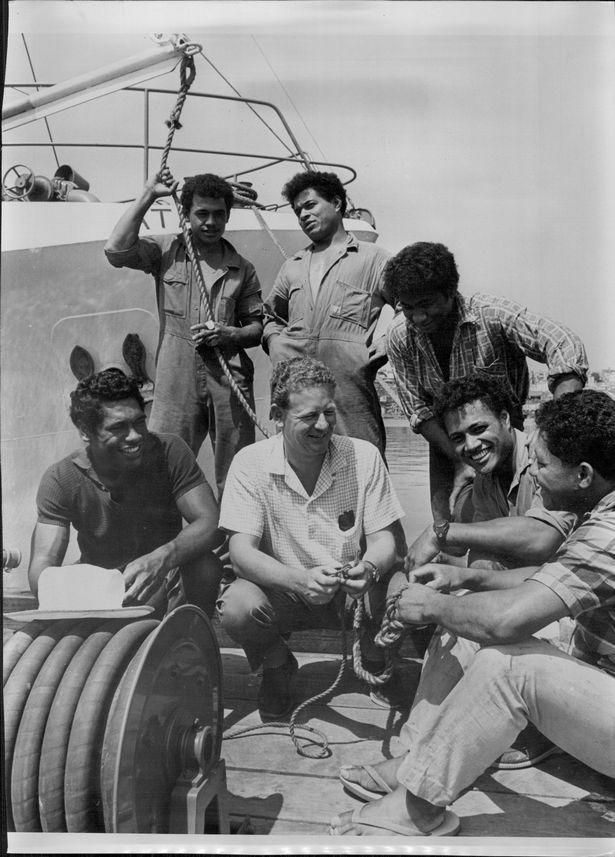Real-life Lord of the Flies saw shipwrecked schoolboys turn ‘cursed’ island into paradise – World News
It was the black burnt patches amidst the luscious green which first caught Peter Warner’s eye as he sailed alone past a deserted Pacific island.
Then he blinked in disbelief as through his binoculars he saw a naked teenage boy, with shoulder-length hair, darting along the cliffside.
Next he and other boys had jumped into the water and were swimming in his direction, screaming at the top of their lungs.
“My name is Stephen,” the first boy said in perfect English as he reached Peter’s boat. “There are six of us and we reckon we’ve been here 15 months.”
Peter was already a well-known figure in his home country, the youngest son of one Australia’s richest men who, aged 17, had spurned his chance to take over his father’s electronics company and ran away to sea in search of adventure.
Over the next few years he became an accomplished and celebrated sailor, winning the Sydney Hobart Yacht Race three times in the 1960s, although he did eventually reluctantly join his father’s firm.
But it was his encounter on September 11, 1966 with a group of marooned boys as he breezed past ‘Ata, a minuscule but paradisiacal island at the far end of the Tonga archipelago, which would earn him worldwide fame.
What is your view? Have your say in the comment section

(Image: Fairfax Media via Getty Images)
Unbeknown to Peter, he had come across a group of shipwrecked public school boys who had been marooned on the remote island for 15 months, and who had been given up for dead by their families who had even held funerals for all of them.
The incredible story, which was compared to the William Golding’s 1954 novel Lord of the Flies, has been remembered again after Peter, still sailing aged 90, died earlier this month when his yacht capsized off Australia’s New South Wales coast. Tides at the notoriously dangerous Ballina Bar threw him overboard and although a fellow sailor dragged his body to shore, paramedics weren’t able to revive him.
Speaking of the moment he first saw the six teenage castaways, Peter remembered: “The first figure was swimming towards me doing the Australian crawl, as I call it.
“And then another five bodies leapt off the cliff and into the water and followed him.”
Peter knew that ‘Ata hadn’t been inhabited since 1863, when a slave ship had arrived and kidnapped the natives, taking them to Peru and leaving the island cursed and deserted ever since.

(Image: Fairfax Media via Getty Images)
At first wary of the boys’ claims, the skipper radioed Tonga’s capital, Nuku’alofa, to verify the story.
“The operator very tearfully said, ‘it’s true’,” Peter later recalled. “‘These boys were students. They’ve been given up for dead. Funerals have been held. And now you’ve found them’.
“It was a very emotional moment for all of us.”
As more details emerged of how the boys – Sione, Stephen, Kolo, David, Luke and Mano – had found themselves shipwrecked, and how they had survived for so long on their own, the more incredible the story became.
Sick of school meals and bored of life at their strict Catholic boarding school in Nuku’alofa, the boys – aged between 13 and 16 – decided to ‘borrow’ a boat from a local fisherman and try to escape to Fiji, some 500 miles away.
Taking with them two sacks of bananas, a few coconuts and a small gas burner, they sailed out of the harbour.

(Image: Two Arts/Cd/Kobal/REX/Shutterstock)
Mano Totau later explained the boys’ desire to leave their boarding school: “We were not happy where we were. If you were in a place, you don’t know where it is, and also you did not see any part of your family, I don’t think you’d be happy to be there… you won’t be happy until you see your family.”
But that night, after all the boys had fallen asleep, a huge storm ripped the boat from its anchor, tearing off the sail and rudder and leaving the vessel drifting directionless on the open ocean.
Sione Fataua recalled how they were sure they would die. “No food, no water. We were just drifting around by the wind. And after eight days we saw the island.”
The boys had drifted more than 100 miles off course and landed on the uninhabited island of ‘Ata. The boat ended up crashing into the rocky shore and shattering as the boys scrambled to safety on land.
Mano remembered: “When I reach the shore, I tried to stand up but when I stand up the whole world is spinning, so I laid down and crawl ashore and when I touch the grass, then I lie down.

(Image: Two Arts/Cd/Kobal/REX/Shutterstock)
“We were very happy, but the first thing we did, we say a prayer, thank God for what he brought us to.”
Desperate to quench their thirst, they then hunted sea bird, drank their blood and drained their eggs. “After that, we all fell down there and sleep until the sunrise the next morning woke us up.”
What happened next was very different to the Lord of the Flies story, in which the British schoolboys stranded on a deserted Pacific island proved incapable of governing themselves.
In the real life survival story the teenage castaways organised themselves into teams of two, drawing up a strict roster for garden, kitchen and garden duty, and after managing to light a fire tended the flame so it never went out.
They survived at first on fish, coconuts and birds, but later found an ancient volcanic crater where they discovered wild taro, bananas and chickens, which had been reproducing since the last Tongans had left.

(Image: Fairfax Media via Getty Images)
When one boy fell off a cliff and broke his leg, the others set his leg using sticks and leaves until it had completely healed.
One of the boys, Kolo, even made a makeshift guitar from a piece of driftwood, half a cocoanut shell and six steel wires salvaged from their wrecked boat – an instrument Peter kept for the rest of his life.
Peter wrote in his memoirs how the boys “had set up a small commune with food garden, hollowed-out tree trunks to store rainwater, a gymnasium with curious weights, a badminton court, chicken pens and a permanent fire, all from handiwork, an old knife blade and much determination.”
Of the moment he finally stepped aboard Peter’s yacht, Manu said: “I could not explain how we feel, all of us, we are full of tears, happy, and like we walk through to heaven.”
But their adventure didn’t end there. On their return to Nuku’alofa the boys were imprisoned after the owner of the boat they had taken decided to press charges.

The Mirror’s newsletter brings you the latest news, exciting showbiz and TV stories, sport updates and essential political information.
The newsletter is emailed out first thing every morning, at 12noon and every evening.
Never miss a moment by signing up to our newsletter here.
Peter was eventually able to secure their release from jail by selling the Australian film rights to their story and using the money to pay for a replacement boat. The boys then returned to ‘Ata to reenact their time there for the Channel Seven documentary.
When the boys were finally returned home the sailor was proclaimed a national hero. Peter remembers arriving at the little island of Ha’afeva where most of the boys were from: “The whole population of this little island were on the beach, hugging the boys. Parents were crying. Then the party started. Six days of feasting.”
Sione remembered the moment he was reunited with his family. “My mum, she was swimming out before I get out the boat. I’m the first one going to the beach, and give me a hug.”
Peter was also invited to an audience with Tonga’s King Taufa‘ahau Tupou IV, a meeting which meant his lifelong wish to turn his back on his father’s electronics firm and live his life on the sea finally came true.
After the king granted Peter’s request to trap lobster in Tonga’s waters and start a business there, he resigned from the company, commissioned a new ship then hired the boys he had rescued as the crew of his new fishing boat.
Incredibly, eight years later, Peter was involved in the rescue of another group of castaways, after he came across four sailors who had been shipwrecked on a remote reef in the Tasman Sea.
The crewman who sighted their distress flashes from a mirror was Mano, by then a deckhand on Peter’s ship.
It is no wonder Peter, who is survived by his wife Justine, son Peter, daughter Janet and adopted daughter Carolyn, wrote three volumes of his memoirs.
Talking recently about his “lifelong friendship” with the boys he rescued, and their families, he said: “We both believe in the same thing. We have the common beliefs that got them through that trial on the island, you know, love, compassion, justice and unity.”


